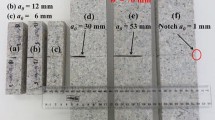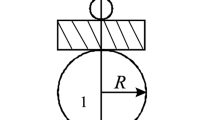Abstract
To examine the size effects on the bending strength of rock and determine the relation between Brazilian splitting strength and bending strength, Brazilian splitting tests were performed to measure the indirect tensile strength of rock materials. Three-point bending tests were used to evaluate the bending properties of rock beam by changing the sample cross section size including height, width, and diameter. The peak load increases as section size linearly expands. An exponential relation between the peak load and the cross section area ratio is found for rectangular section with different heights and circular section with different diameters samples, whereas a linear one is observed for rectangular section with different widths samples. The measured peak load ratio for all tested samples actually differs from the theoretical one. The maximum shear stress on the cross section of the sample is linearly affected by the section height and diameter but hardly influenced by the section width. Bending strength is barely affected by section size which leads to the conclusion that no size effect is observed in the tested size range. However, the ratio of bending strength to Brazilian tensile strength is found within 3.81–4.26 for rectangular samples and 3.14–3.48 for circular samples. The obtained bending strength is higher than the Brazilian tensile strength, which is in good agreement with the previous results, and the bending strength to Brazilian tensile strength ratio is associated with the sample section size.













Similar content being viewed by others
Abbreviations
- t :
-
Vertical distance, mm
- P :
-
Vertical load, kN
- RSDH:
-
Rectangular section with different heights
- RSDW:
-
Rectangular section with different widths
- CSDD:
-
Circular section with different diameters
- L s :
-
Length of sample in three-point bending test, mm
- H :
-
Height of rectangular cross-section, mm
- W :
-
Width of rectangular cross-section, mm
- L :
-
Support span length, mm
- H b :
-
Height of cylindrical sample in Brazilian test, mm
- D :
-
Diameter of cylindrical sample, mm
- σ t :
-
Indirect tensile strength obtained from Brazilian splitting test, MPa
- \(\bar{\sigma }_{t}\) :
-
Average value of indirect tensile strength, MPa
- \(\bar{\sigma }_{f}\) :
-
Average value of bending strength, MPa
- r :
-
Ratio of \(\bar{\sigma }_{f}\) to \(\bar{\sigma }_{t}\)
References
Agioutantis Z, Kaklis K, Mavrigiannakis S et al (2016) Potential of acoustic emissions from three point bending tests as rock failure precursors. Int J Min Sci Technol 26:155–160
Aliha MRM, Hosseinpour GR, Ayatollahi MR (2013) Application of cracked triangular specimen subjected to three-point bending for investigating fracture behavior of rock materials. Rock Mech Rock Eng 46:1023–1034
Aliha MRM, Bahmani A, Akhondi S (2016) Mixed mode fracture toughness testing of PMMA with different three-point bend type specimens. Eur J Mech A Solids 58:148–162
Ayatollahi MR, Aliha MRM (2007) Fracture toughness study for a brittle rock subjected to mixed mode I/II loading. Int J Rock Mech Min 44:617–624
Cabrero JM, Vargas G (2015) Analysis of the validity of the three-point off-axis bending method. Appl Math Model 39:5265–5277
Chang SH, Lee CI, Jeon S (2002) Measurement of rock fracture toughness under modes I and II and mixed-mode conditions by using disc-type specimens. Eng Geol 66:79–97
Chen CS, Pan E, Amadei B (1998) Determination of deformability and tensile strength of anisotropic rock using Brazilian tests. Int J Rock Mech Min 35:43–61
Cooper GA (1977) Optimization of the three-point bend test for fracture energy measurement. J Mater Sci 12:277–289
Efimov VP (2009) The rock strength in different tension conditions. J Min Sci 45:569–575
Erarslan N, Williams DJ (2012) Experimental, numerical and analytical studies on tensile strength of rocks. Int J Rock Mech Min 49:21–30
Erarslan N, Liang ZZ, Williams DJ (2012) Experimental and numerical studies on determination of indirect tensile strength of rocks. Rock Mech Rock Eng 45:739–751
Fahimifar A, Malekpour M (2012) Experimental and numerical analysis of indirect and direct tensile strength using fracture mechanics concepts. Bull Eng Geol Environ 71:269–283
Hayashi K, Ono A, Abe H (1989) BEM analysis of a cylindrical three point bend specimen with a chevron crack for fracture toughness test of rock. Nihon Kikai Gakkai Ronbunshu A Hen/Trans Jpn Soc Mech Eng Part A 54:1541–1545
ISRM (1978) Suggested methods for determining tensile strength of rock materials. Int J Rock Mech Min 15:99–103
Khan K, Al-Shayea NA (2000) Effect of specimen geometry and testing method on mixed mode I–II fracture toughness of a limestone rock from Saudi Arabia. Rock Mech Rock Eng 33:179–206
Komurlu E, Kesimal A (2015) Evaluation of indirect tensile strength of rocks using different types of jaws. Rock Mech Rock Eng 48:1723–1730
Lim IL, Johnston IW, Choi SK et al (1994) Fracture testing of a soft rock with semi-circular specimens under three-point bending. Part 1—mode I. Int J Rock Mech Min 31:185–197
Lin H, Xiong W, Zhong WW et al (2014) Location of the crack initiation points in the Brazilian disc test. Geotech Geol Eng 32:1339–1345
Lin H, Xiong W, Xiong Z et al (2015) Three-dimensional effects in a flattened Brazilian disk test. Int J Rock Mech Min 74:10–14
Lin H, Xiong W, Yan Q (2016) Modified formula for the tensile strength as obtained by the flattened Brazilian disk test. Rock Mech Rock Eng 49:1579–1586
Nuri TM, Ali ANY, Ahmed S (2012) Correlation study between point load test and uniaxial compressive strength and tensile strength of some sedimentary rocks in Mosul city. Eng Tech J 30:155–166
Park SJ, Lee JR (1998) Bending fracture and acoustic emission studies on carbon–carbon composites: effect of sizing treatment on carbon fibres. J Mater Sci 33:647–651
Prasad BKR, Sagar RV (2008) Relationship between AE energy and fracture energy of plain concrete beams-experimental study. J Mater Civ Eng 20:212–220
Shan Z, Porter I, Nemcik J et al (2014) Effect of different curing conditions on the compressive and flexural properties of Plaster of Paris. Microform Publications, College of Health, Physical Education and Recreation, University of Oregon
Wei MD, Dai F, Xu NW et al (2016) Experimental and numerical study on the cracked chevron notched semi-circular bend method for characterizing the mode I fracture toughness of rocks. Rock Mech Rock Eng 49:1595–1609
Weinberger R, Reches Z, Eidelman A et al (1994) Tensile properties of rocks in four-point beam tests under confining pressure. American Rock Mechanics Association, Alexandria
Xu N, Dai F, Sha C et al (2015) Microseismic signal characterization and numerical simulation of concrete beam subjected to three-point bending fracture. J Sens, article ID: 987232
Zhang ZX (2016) An empirical relation between mode I fracture toughness and the tensile strength of rock. Int J Rock Mech Min 39:401–406
Zhao Y, Wang Y, Wang W et al (2017) Modeling of non-linear rheological behavior of hard rock using triaxial rheological experiment. Int J Rock Mech Min 93:66–75
Zhou XP, Qian QH, Yang HQ (2010) Effect of loading rate on fracture characteristics of rock. J Cent South Univ 17:150–155
Zietlow WK, Labuz JF (1998) Measurement of the intrinsic process zone in rock using acoustic emission. Int J Rock Mech Min 35:291–299
Acknowledgements
This paper gets its funding from project (51474249, 51774322) supported by National Natural Science Foundation of China; Project (2016CX019) supported by Innovation-driven Plan in Central South University; Project (2016M602742) supported by China Postdoctoral Science Foundation; Open Fund of Key Laboratory of Bridge Engineering Safety Control by Hunan Province, Department of Education (Changsha University of Science and Technology) (15KB02); Open Fund of Engineering Research Center of Catastrophic Prophylaxis and Treatment of Road and Traffic Safety of Ministry of Education (Changsha University of Science and Technology kfj150405); Opening fund of State Key Laboratory of Geohazard Prevention and Geoenvironment Protection (SKLGP2016K009). The authors wish to acknowledge these supports.
Author information
Authors and Affiliations
Corresponding author
Rights and permissions
About this article
Cite this article
Fan, X., Lin, H. & Cao, R. Bending Properties of Granite Beams with Various Section-Sizes in Three-Point Bending Tests. Geotech Geol Eng 37, 1–11 (2019). https://doi.org/10.1007/s10706-018-0504-0
Received:
Accepted:
Published:
Issue Date:
DOI: https://doi.org/10.1007/s10706-018-0504-0




